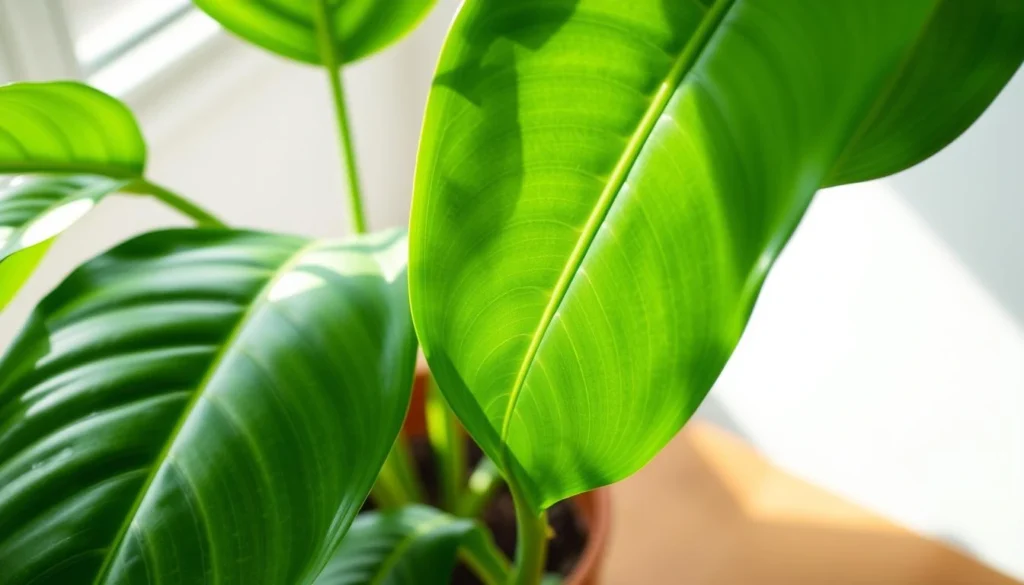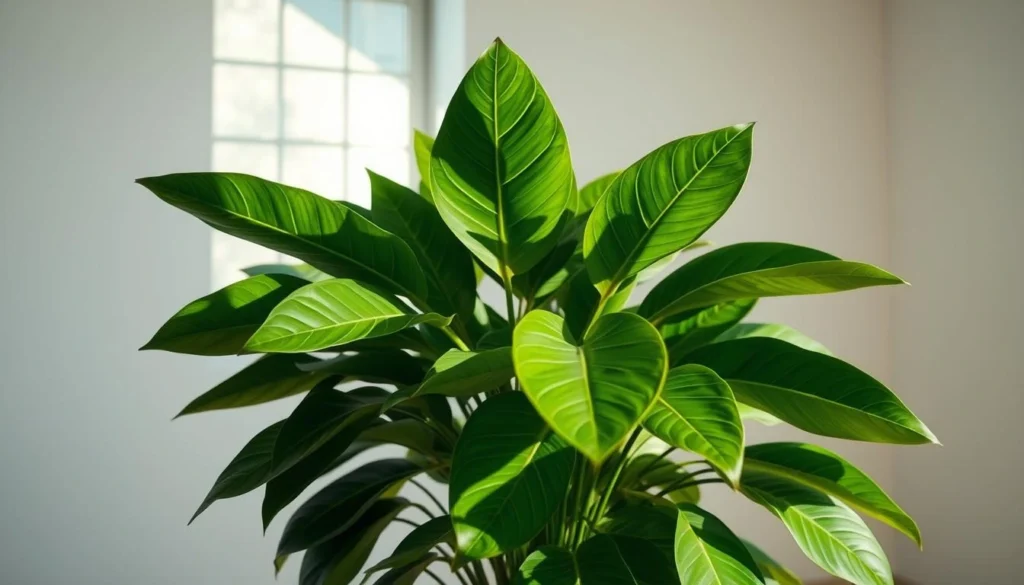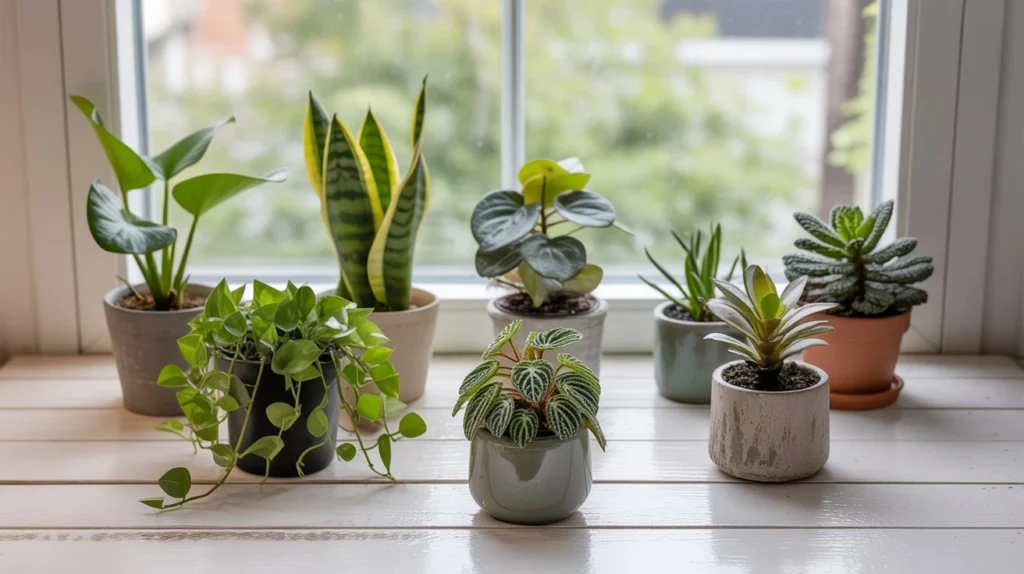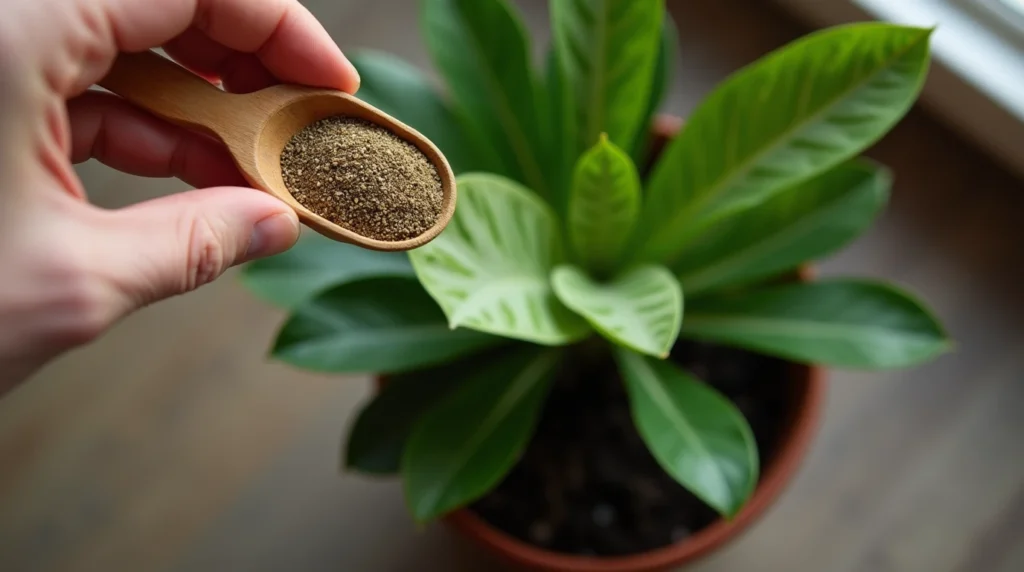
Want to add some green to your home? Rubber plants are great for indoor spaces. They have big, shiny leaves and clean the air. With the right care, they can make any room look better.
We’ll show you how to keep your rubber plant happy and healthy. By the time you finish this guide, you’ll know how to make your indoor rubber plant thrive.
Understanding Your Rubber Plant
Knowing your rubber plant is key to giving it the best care. It’s important to understand its type and how it grows naturally.
Common Varieties of Indoor Rubber Plants
Rubber plants have different species. Ficus elastica and Ficus robusta are favorites for indoor gardens. They have big, dark green leaves and can grow very tall.

Natural Habitat and Growth Patterns
In the wild, rubber-plants can reach up to 50 feet tall. They come from Southeast Asia and love humid, sunny spots. By mimicking these conditions indoors, your plant will stay healthy and grow well.
Understanding how they grow helps you care for them better. You can prune them to keep them small and give them the right light. This way, you’re using the best caring for rubber plants indoors methods.
Best Rubber-Plant for Indoors
Choosing the best rubber plant for indoors involves several factors. You need to think about the size of your space, the light it gets, and how much care you can give.
Ficus Elastica Varieties
Ficus elastica, or the rubber-plant, has many varieties perfect for indoor spaces. ‘Robusta’ and ‘Tineke’ are favorites for their big, shiny leaves and smaller size.
Size and Growth Considerations
When picking a rubber-plant, think about its full size and how fast it grows. Some can get really tall, while others stay small. Table 1 shows how different Ficus elastica varieties grow.
| Variety | Mature Height | Growth Rate |
|---|---|---|
| ‘Robusta’ | 6-8 feet | Moderate |
| ‘Tineke’ | 4-6 feet | Slow |
| ‘Decora’ | 8-10 feet | Fast |

By considering these factors and picking the right variety, you can have a healthy rubber plant indoors.
Ideal Growing Conditions for Rubber Plant Indoor
To keep your rubber-plant thriving indoors, it’s essential to understand its ideal growing conditions. Your rubber plant’s environment plays a significant role in its health and growth.
Light Requirements
Rubber plants prefer bright, indirect light. Direct sunlight can cause the leaves to become scorched. It’s best to place them near an east- or west-facing window. Avoid placing your rubber-plant in a spot with low light, as this can lead to weak and leggy growth.
Temperature and Humidity Needs
Rubber-plants thrive in temperatures between 60°F to 85°F (15°C to 30°C). They also prefer a humid environment, typically above 40% relative humidity. You can increase the humidity around your plant by placing it on a tray filled with water and pebbles or using a humidifier.
Best Locations in Your Home
Considering the light, temperature, and humidity requirements, the best locations for your rubber-plant are areas that are bright but not directly sunny. They should also be away from drafts and extreme temperatures. A well-insulated living room or a bright, airy bedroom can be an ideal spot.
| Condition | Ideal Range | Tips |
|---|---|---|
| Light | Bright, Indirect | East- or west-facing window |
| Temperature | 60°F – 85°F | Avoid drafts and extreme temps |
| Humidity | Above 40% | Use a humidifier or water tray |
Soil and Potting Requirements
Choosing the right soil mix and pot is key for your indoor rubber plant to thrive. The right mix supports healthy roots and prevents root rot.
Selecting the Right Soil Mix
A well-draining potting mix is vital for indoor rubber plants. You can make your own mix with peat moss, perlite, and vermiculite. This mix prevents water from staying too long in the soil, reducing root rot risk.
Don’t use regular garden soil. It’s too dense and can cause waterlogging.
Choosing the Perfect Pot
The pot needs drainage holes to keep water out of the soil. A pot that’s too small can limit root growth. A pot that’s too big can make the soil too wet.
Opt for pots made from breathable materials like terracotta or ceramic. These materials help control moisture and create a healthy root environment for your rubber-plant.
Watering and Fertilizing Your Rubber-Plant
Watering and fertilizing your indoor rubber plant is key to its health. You must find the right balance of water and nutrients. This balance is essential for your plant’s well-being.
Watering Frequency and Technique
Check the soil’s moisture by feeling the top 2-3 inches. This helps you know when to water. Use lukewarm water to avoid shocking the roots.
Signs of Overwatering and Underwatering
Look out for yellow leaves or droopy stems from too much water. Dry, crispy leaves mean it’s not getting enough. Adjust your watering to avoid these problems.
Fertilizing Schedule and Types
Feed your rubber plant with a balanced fertilizer during the growing season. Use half the recommended strength to protect the roots. Fertilize once a month for the best results.
By following these indoor rubber-plant care tips, your plant will stay healthy and flourish.
How to Propagate Rubber Plant Indoors
You can easily grow your rubber plant indoors using stem cuttings or air layering. These methods are simple and effective. They let you multiply your plants and share them with others.
Stem Cutting Method
To start, pick a healthy stem section with at least two nodes. Cut the stem just below a node with a clean, sharp tool. Then, remove lower leaves, leaving a few at the top.
Place the cutting in a glass of water or moist soil. Roots will grow in a few weeks.
Air Layering Technique
Air layering roots a stem section while it’s attached to the parent plant. Make a small cut in the stem, just below a node. Wrap the area with moist sphagnum moss.
Use plastic wrap to keep it moist. Roots will grow in a few weeks. Once roots are visible, cut the stem below them. Then, pot the new plant.
Rubber Plant Indoor Decoration
Adding rubber-plants to your home decor can make any room look better. Their big, dark green leaves bring a tropical feel. They can make your indoor space look stylish.
Styling Tips for Different Rooms
Rubber plants can do well in many rooms if they have the right conditions. In living rooms, put one in a corner for a green highlight. In bedrooms, they can help relax you. Here are some styling tips:
- Choose a pot that fits your room’s style.
- Think about the plant’s size when picking a spot.
- Combine rubber-plants with other plants for a lively indoor garden.
Pairing with Other Houseplants
Pairing rubber plants with other plants makes your indoor garden diverse and healthy. Some good matches include:
- Snake Plants for being easy to care for and cleaning the air.
- Peace Lilies for their beautiful white flowers and air-purifying power.
- Dracaena for being flexible and growing well in different light.
By adding rubber plants to your indoor garden, you get cleaner air and a prettier space. It’s a win-win.
Read More :
Grow a Thriving Monstera Indoor Plant
Conclusion
To keep your rubber-plant indoor healthy, follow the care tips in this article. It’s important to know its specific needs. This includes light, temperature, watering, and fertilizing.
Choosing the right soil and pot is also key. You can even propagate and style your rubber plant with other houseplants. This makes it more beautiful and beneficial.
With the right care, your rubber plant will purify the air and make your home look better. It will also bring you peace and a connection to nature.
Now you know how to care for your rubber plant indoor. Enjoy the many benefits it brings to your home. With a little care, it will continue to grow and bring joy for years.
FAQ
What are the benefits of having a rubber plant indoors?
A rubber-plant can purify the air and make your space look better. It also helps reduce stress. Plus, they are easy to care for, perfect for those with busy lives.
How often should I water my indoor rubber plant?
Water your rubber plant when the top inch of soil is dry. This depends on your home’s humidity and temperature. Don’t overwater to avoid root rot.
Can I propagate my rubber plant using stem cuttings?
Yes, you can use stem cuttings to propagate your rubber-plant. Choose a cutting with two nodes, remove leaves, and plant it in moist soil. Keep it warm until roots grow.
What is the ideal temperature for my indoor rubber plant?
The best temperature for your rubber plant is 65°F to 75°F (18°C to 24°C). Keep it away from vents, fireplaces, and drafty windows.
How can I style my rubber plant in my home decor?
You can place your rubber plant on a shelf or as a floor plant. Choose a spot based on its size, shape, and color. Grouping with other plants can also look great.
Can I grow a rubber plant in low-light conditions?
Rubber plants can handle low light but prefer bright, indirect light. For low-light, pick varieties like Ficus elastica ‘Decora’.
How often should I fertilize my indoor rubber plant?
Fertilize your rubber plant in spring and summer with a balanced fertilizer. Use half the recommended strength to avoid harming the roots.
What are some common pests that can affect my indoor rubber plant?
Spider mites, mealybugs, and scale can harm your rubber-plant. Check your plant often and treat any pests quickly to prevent damage.

